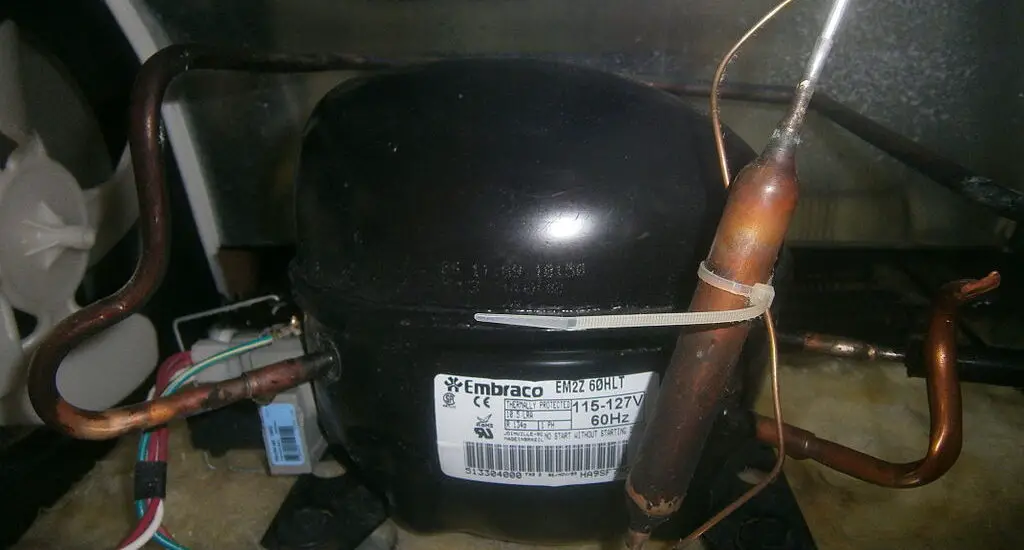“Where is refrigerator compressor located?” This comprehensive guide will break down the steps to locate your fridge’s compressor.

Table of Contents
Where is Refrigerator Compressor Located? Common Locations
The location of the compressor in your refrigerator varies based on the design and manufacturer. While the function remains the same, the placement can differ for a variety of reasons, including space optimization and cooling efficiency. Below are the general areas where compressors are commonly placed.
At the Back
The majority of refrigerators have the compressor located at the lower rear side. It’s typically concealed behind a removable metal or plastic panel. To access it, you’ll need to move your fridge away from the wall and unscrew the panel. This placement allows for easier expulsion of heat into the surrounding air.
Underneath
Some designs, particularly compact or built-in units, have the compressor underneath the fridge. You may need to lie on the floor and look under the fridge to find it. It’s usually covered by a detachable panel, either at the front bottom or the rear bottom of the unit. Removing a few screws should give you access.
Separate Housing
Commercial or highly specialized refrigeration systems might have the compressor in a completely separate unit. This design allows for more powerful compressors and more flexible placement. For these systems, always refer to the user manual or contact the manufacturer for precise instructions.
How to Find Your Refrigerator Compressor
Locating the compressor requires a systematic approach. Even if you’re a complete beginner, don’t worry. Here’s a foolproof guide:
Unplug the Refrigerator: Always start by unplugging the refrigerator from the electrical outlet. This step is essential for your safety to avoid any electrical shock or injuries.
Move the Fridge Carefully: If the compressor is at the back, gently pull the fridge away from the wall. Make sure you don’t pull too quickly, as this could disconnect or damage any water or electrical lines connected to the fridge.
Remove Panels: Now identify the panel you need to remove. Use a suitable screwdriver to remove the screws holding the panel in place. Keep these screws in a safe location, so you don’t lose them.
Check out this Hyper Tough 44 Piece Precision Multi-type Screwdriver Bits Set from Walmart.
Identify the Compressor: Behind the panel, you’ll find various components. The compressor is a large, cylindrical metal object. It has copper tubes and electrical wires connected to it. The copper tubes usually go in and come out, and they’re a good indicator you’re looking at the compressor.
Consult the Manual: If you’re still unsure, consult your refrigerator’s user manual. The manual will contain detailed diagrams and information on how to locate and identify the compressor.
Check out these other articles…
Refrigerator Compressor Is Too Hot: Fixed in 4 Easy Steps
Refrigerator Compressor is Warm: 3 Easy Solutions
Refrigerator Compressor Cut Off Time: The Ultimate Guide
Refrigerator Compressor Only Runs for a Few Minutes: Fixed
Refrigerator Compressor Output Pressure: Comprehensive Guide
Is an Inverter Compressor Refrigerator Good? Detailed Answer
Safety Tips
Safety is paramount when dealing with appliances like refrigerators. Here are some tips to ensure you stay safe while locating the compressor:
Unplug Before You Start: An unplugged fridge is a safe fridge. It minimizes risks associated with electrical shocks.
Use Protective Gear: Always wear protective gloves to shield your hands from sharp edges and electrical components. You may also want to wear safety goggles to protect your eyes.
Don’t Disassemble: The compressor itself is a sealed unit containing refrigerant gas under high pressure. Attempting to open or dismantle it can result in injury or harmful exposure to the refrigerant. Never try this unless you’re a certified technician.
Follow Guidelines: Always follow the manufacturer’s guidelines or consult with professionals when in doubt. It’s better to seek expert advice than to risk your safety.